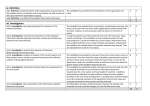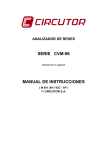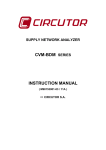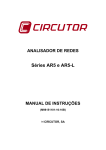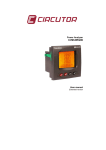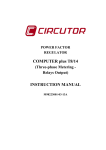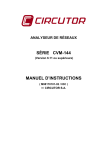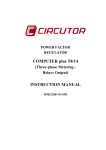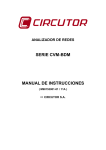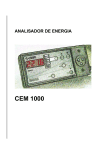Download CVM-144 SERIES (Ethernet) INSTRUCTION MANUAL
Transcript
SUPPLY NETWORK ANALYZER
CVM-144 SERIES
(Ethernet)
(Ver 6.11 and higher)
INSTRUCTION MANUAL
(M98203401-03-06A)
CIRCUTOR S.A.
----- Supply network analyzer CVM-144 ------ User's manual ---
CONTENTS
1.2.3.4.-
5.6.-
7.8.9.10.11.-
12.-
13.14.-
Page No. 1
page
DELIVERY SPOT CHECK ..........................................................................................................2
MAIN FEATURES........................................................................................................................3
MODELS......................................................................................................................................5
INSTALLATION AND START-UP ...............................................................................................6
4.1.- Installation......................................................................................................................6
4.2.- CVM-144 connection terminal arrangement (power supply connection terminal) .............................8
4.3.- CVM-144 connection terminal arrangement (Expansion card) .....................................9
4.4.- Connection drawing for the CVM-144 : .......................................................................14
OPERATION MODE..................................................................................................................18
SET-UP PROCEDURE .............................................................................................................20
6.1.- Phase-to-Phase or Phase-to-Neutral voltages............................................................21
6.2.- Voltage display mode ..................................................................................................21
6.3.- Voltage transformation ratio ........................................................................................22
6.4.- Current Transformer Primary.......................................................................................23
6.5.- Transformation ratio for the measurement of neutral and residual current.................24
6.6.- Setting power demand utility screens..........................................................................26
6.7.- Initial screen setting .....................................................................................................27
6.8.- Setting of the display shutdown time ...........................................................................27
6.9.- Clearing energy counters ............................................................................................28
6.10.- THD or D setting ........................................................................................................29
6.11.- Additional screens when RELAY OUTPUTS (2 relays) are equipped ......................30
6.12.- Additional screens with 4 - 20 mA outputs y inputs...................................................37
SPECIFICATIONS.....................................................................................................................42
SAFETY CONSIDERATIONS ...................................................................................................44
MAINTENANCE.........................................................................................................................44
TECHNICAL SERVICE .............................................................................................................44
CVM-144 COMMUNICATIONS.................................................................................................45
11.1.- To take into account !: ...............................................................................................45
11.2.- RS-485 type connection to a RS-232 type input of a PC ..........................................46
11.3.- RS-232 type connection to a RS-232 type input of a PC ..........................................47
11.4.- MODBUS © protocol.................................................................................................48
APPENDIX A: Second SET-UP of the CVM-144 .....................................................................54
12.1.- Communication setting ..............................................................................................54
12.2.- SET-UP locking or unlocking.....................................................................................55
APPENDIX B: Insertion of an expansion module into a CVM-144 unit.....................................56
APPENDIX C: Ethernet communication, MODBUS/TCP..........................................................58
----- Supply network analyzer CVM-144 ------ User's manual ---
Page No. 2
1.- DELIVERY SPOT CHECK
This manual is issued to help all the CVM-144 (Version 6.11 and higher) users
to install and use it in order get the best from it. After receiving the unit, please check
the following points:
(a) Does this device correspond to your order specifications?
(b) Check if any damage was done during the shipment process.
(c) Verify that it includes the correct instruction manual.
The manual you hold in your hands contains information and warnings
about the CVM-144 that the user should respect in order to guarantee
a proper operation of all the instrument functions and keep its safety
conditions.
Before powering the instrument for the first time, verify following points:
(a) Power supply: see rear part of your CVM-144
Standard: 230 V a.c. Single-phase, Frequency: 50 ... 60 Hz
SDC Model : 24 .... 120 V c.c.
Other supply voltages, on request.
(b) Maximum measuring voltage:
Standard: 300 V a.c. phase-neutral / 520 V a.c. between phases
Other models: on request
CVM144 - measuring 110V: 110 V a.c. phase-to-neutral /190 V a.c. phase-to-phase
CVM144 - measuring 500V: 500 V a.c. phase-to-neutral /866 V a.c. phase-to-phase
(c) Maximum measurable current: Current transformer of In / 5 A a.c.
----- Supply network analyzer CVM-144 ------ User's manual ---
Page No. 3
2.- MAIN FEATURES
The CVM-144 power meter is a programmable measuring instrument, offering
several operation possibilities selectable in its SET-UP option. Before power
supplying the instrument, read the CONNECTIONS and SET-UP sections and
choose the most suitable operation mode for getting your desired data.
reset
The CVM-144 is an instrument which measures, calculates and displays all the
main electrical parameters at any electrical network (balanced or not). The measuring
is true RMS value, through three a.c. voltage inputs and three a.c. current inputs
(from Current Transformers .../ 5A).
----- Supply network analyzer CVM-144 ------ User's manual ---
Page No. 4
By means of an internal microprocessor it simultaneously measures:
Parameter
Symbol
Voltage (phase-neutral)
Voltage (phase-phase)
Current
Frequency
Active power
Reactive power L
Reactive power C
Apparent power
Power factor
Cos ϕ
Power demand
kW h
kvarhL
kvarhC
Neutral current
Voltage THD
Current THD
Individual harmonic
current content (Up to the 15th)
Analog inputs
Earth leakage (residual) current
Available:
V
V
A
Hz
kW
kvarL
kvarL /(-C)
kVA
PF
Pd
energy
energy
energy
IN
% THD- V
% THD- A
L1 L2 L3
x
x
x
x
x
x
x
x
x
x
x
x
x
x
x
x
x
x
x
x
x
x
xx
x
x
x
xx
x
xx
x
x
x
x
x
x
xx
x
x
xx
Input
x: Display and communications
Average
x
x
x
xx
xx
x
xx: Communications
The CVM-144 delivers the visualization of above listed parameters by means
of three 4-digit, led type, displays. Up to 3 parameters can be simultaneously read in
the screen.
--------------------------------------------------------------------------------------------OTHER FEATURES
-
Low-size (144 x 144 mm), panel-mounting analyzer.
True R.M.S. measuring system.
Collection in memory of maximum and minimum values.
Energy measurement (indication through a lighting led)
RS-485 or RS-232 type communication to a PC (optional)
Maximum demand determination: kW, kVA, AIII or line-current.
----- Supply network analyzer CVM-144 ------ User's manual ---
Page No. 5
CVM-144
CVM-144-ITF
Shunts
Isolated ITF
Card
Relay outputs
Expansion modules
Mod. CVM 144 C2
Mod. CVM 144 C2 Analogue
Mod. CVM 144 C2-Currents
Mod. CVM 144 C2 Digital
Mod. CVM 144 RS485-C2
Mod. CVM 144 RS485-C2 Analogue
Mod. CVM 144 RS485-C2-Currents
Mod. CVM 144 RS485-C2 Digital
Mod. CVM 144 RS232-C2
Mod. CVM 144 RS232-C2 Analogue
Mod. CVM 144 RS232-C2-Currents
Mod. CVM 144 RS232-C2 Digital
0571
0572
0573
0574
0575
0579
0576
0577
0578
0580
RS485
RS485
RS485
RS485
RS232
RS232
RS232
RS232
2
2
2
2
2
2
2
2
2
2
2
2
Measurement of
neutral and residual
currents
7 70 551
7 70 552
Analogue outputs
Current
measurement
Analogue inputs
Model
Communication
Code
7 70 570
7 70 571
7 70 572
7 70 569
7 70 573
7 70 574
7 70 575
7 70 579
7 70 576
7 70 577
7 70 578
7 70 580
Code
Digital inputs
3.- MODELS
3* 1*
X
4
3* 1*
X
4
3* 1*
X
4
Optionally 2 analog inputs and 2 analog outputs.
Code
Complete Kit
Communications
Relay
Outputs
Current
inputs
7 70 591
CVM-144-ITF-RS485-C2
RS-485
2
Isolated ITF
Each CVM 144 supports as a maximum 1 expansion module
----- Supply network analyzer CVM-144 ------ User's manual ---
Page No. 6
4.- INSTALLATION AND START-UP
The manual you hold in your hands contains information and warnings
that the user should respect in order to guarantee a proper operation
of all the instrument functions and keep its safety conditions. The
instrument must not be powered and used until its definitive assembly
on the cabinet’s door.
If the instrument is not used as manufacturer’s specifications, the
protection of the instrument can be damaged.
When any protection failure is suspected to exist (for example, it presents
external visible damages), the instrument must be immediately powered off. In this
case contact a qualified service representative.
4.1.- Installation.
Before powering the instrument for the first time, verify following points:
a.- Power supply: see rear part of your CVM-144
Standard supply :
Single-phase 230 V ∼ (a.c.)
- Frequency
: 50 - 60 Hz
- Supply voltage tolerance : - 10 % / + 15
- Connection terminal
: Terminals 1 - 2 (Power supply)
- Burden
: 5 VA
SDC Model
: 0.24.... 120 V c.c. ( continua )
- Supply voltage tolerance : - 20 % / + 15
- Connection terminal
: Terminals 1 - 2 (Power supply)
- Burden
: 2,2 W
On request: other voltages
----- Supply network analyzer CVM-144 ------ User's manual ---
Page No. 7
b.-Maximum voltage at the voltage measuring circuit:
Standard : 300 V a.c. phase-to-neutral/520 V a.c. phase-to-phase
45 to 65 Hz
Other models on request :
CVM-144-measuring 500 V: 500 Va.c. phase-to-neutral/866 Va.c. phase-to-phase
CVM-144-measuring 110 V: 110 Va.c. phase-to-neutral/190 Va.c. phase-to-phase
c.- Maximum allowable current : Current Transformer of In / 5 A a.c.
d.- Operation conditions :
- Operation temperature range : -10 to +50 ºC
- Humidity
: 5 to 95 % R.H. non-condensing
- Altitude
: below 2000 m
e.- Safety :
-
Designed to meet protection class III- 300 V a.c. as (EN 61010).
Protection against electric shock by class II double-isolation
Mounting:
Instrument is to be mounted on panel (cut-out 138+1 x 138+1 mm, as per DIN
43 700). All connections keep inside the cabinet.
Note that with the instrument powered on, the terminals could be dangerous to
touching and cover opening actions or elements removal may allow accessing
dangerous parts. Therefore, the instrument must not be used until this is completely
installed.
The instrument must be connected to a power supply circuit protected with gl
type (IEC 269 ) or M type fuses rated between 0.5 and 2 A. This circuit should be
provided with a circuit breaker or any equivalent element to connect (ON) or
disconnect (OFF) the instrument from the power supply network. The supply and
measuring voltage circuits will be both connected through a wire with a minimum
cross-section of 1 mm2.
The line of the current transformer secondary will have a minimum crosssection of 2,5 mm2.
----- Supply network analyzer CVM-144 ------ User's manual ---
Page No. 8
4.2.- CVM-144 connection terminal arrangement (power supply connection terminal)
(see lable on the rear part)
I n / 5A
L1
Power Supply
1
P1 P2
2
1
2
3
4
5
6
P1
L2
P-N
300V
L3
S2
S1
S2
S1
S2
S1
N
3
4
5
6
7
8
9
No. Terminal description
*Power supply AL1
*Power supply AL2
IL1 S2 Current measurement
IL1 S1 Current measurement
IL2 S2 Current measurement
IL2 S1 Current measurement
CAT III
P1 P2
P2
230 V
300 V
P-P
520V
VL1 VL2 VL3
10
11
12
No. Terminal description
7
8
9
10
11
12
IL3 S2 Current measurement
IL3 S1 Current measurement
Neutral
VL1 Measurement
VL2 Measurement
VL3 Measurement
NOTE: Terminals 3, 5, 7 are internally connected to the 9 terminal (Neutral)
... / 5 A current inputs are isolated for the ITF model.
* Lower connection terminal (SDC Model)
Nº Descripción Borne
1
2
Supply voltage (+) d.c.
Supply voltage (-) d.c.
----- Supply network analyzer CVM-144 ------ User's manual ---
Page No. 9
4.3.- CVM-144 connection terminal arrangement (Expansion card)
(see lable on the rear part)
4.3.1.- Basic card (770 570, 770 573 and 770 576)
Description
Card connection terminal arrangement
Mod CVM 144 -C2
(Code: 7 70 570)
Mod CVM 144 RS485-C2
(Code: 7 70 573)
Mod CVM 144 RS232-C2
(Code: 7 70 576)
Mod CVM 144 -C2
(Código: 770 570)
No Terminal
description
13
14
15
16
17
18
19
20
21
22
23
24
No used
No used
No used
No used
No used
No used
No used
No used
Relay RL2 output
Relay RL2 common
Relay RL1 output
Relay RL1 common
Mod CVM 144 RS485-C2
(Código: 770 573)
No Terminal description
13
14
15
16
17
18
19
20
21
22
23
24
No used
No used
No used
No used
No used
RS-485 ( GND )
RS-485 ( - )
RS-485 ( + )
Relay RL2 output
Relay RL2 common
Relay RL1 output
Relay RL1 common
Mod CVM 144 RS232-C2
(Código: 770 576)
No Terminal description
13
14
15
16
17
18
19
20
21
22
23
24
No used
No used
No used
No used
No used
RS-232 ( GND )
RS-232 (Rx)
RS-232 (Tx)
Relay RL2 output
Relay RL2 common
Relay RL1 output
Relay RL1 common
----- Supply network analyzer CVM-144 ------ User's manual ---
Page No. 10
4.3.2.- Card for analog Inputs/Outputs (7 70 571, 7 70574 and 7 70577)
Description
Card connection terminal arrangement
Mod CVM 144 -C2-Analogue
(Code: 7 70 571)
Mod CVM 144 RS485-C2-Analogue
(Code: 7 70 574)
Mod CVM 144 RS232-C2-Analogue
(Code: 7 70 577)
Mod CVM 144
C2-Analogue
(Code: 7 70 571)
Nº Terminal description
13
14
15
16
17
18
19
20
21
22
23
24
4-20 mA I/O common
4-20 mA D/A1 output
4-20 mA A/D3 input
4-20 mA A/D2 input
4-20 mA A/D1 input
No used
No used
No used
Relay RL2 output
Relay RL2 common
Relay RL1 output
Relay RL1 common
Mod CVM 144
RS485-C2-Analogue
(Code: 7 70 574)
Nº Terminal description
13
14
15
16
17
18
19
20
21
22
23
24
4-20 mA I/O common
4-20 mA D/A1 output
4-20 mA A/D3 input
4-20 mA A/D2 input
4-20 mA A/D1 input
RS-485 (GND)
RS-485 ( - )
RS-485 ( + )
Relay RL2 output
Relay RL2 common
Relay RL1 output
Relay RL1 common
Mod CVM 144
RS232-C2-Analogue
(Code: 7 70 577)
Nº Terminal description
13
14
15
16
17
18
19
20
21
22
23
24
4-20 mA I/O common
4-20 mA D/A1 output
4-20 mA A/D3 input
4-20 mA A/D2 input
4-20 mA A/D1 input
RS-232 ( GND)
RS-232 ( Rx )
RS-232 ( Tx )
Relay RL2 output
Relay RL2 common
Relay RL1 output
Relay RL1 common
----- Supply network analyzer CVM-144 ------ User's manual ---
Page No. 11
4.3.3.- Module for residual and neutral currents (770 572, 770 575 and 770578)
Description
Lable in the expansion module connection terminal
Mod CVM 144 -C2-Currents
13
14
15
16
13
14
15
16
13
14
15
16
(Code: 7 70 572)
(Code: 7 70 575)
(Code: 7 70 578)
Nº Terminal description
13 Measur. residual current S1
14 Measur. residual current S2
(30 A)
15 Measur. residual current S2
(3 A)
16 Measur. neutral current S1
17 Measur. neutral current S2
18 Not used
19 Not used
20 Not used
21 Relay RL2 output
22 Relay RL2 common
23 Relay RL1 output
24 Relay RL1 common
19
20
21
22
RL2
18
19
G
N
D (-)
20
(+)
21
22
RL2
20
21
22
RL2
250V
17
R
S485
IN
Mod CVM 144 RS232-C2-Currents
(Code: 7 70 572)
18
IN
Mod CVM 144 RS485-C2-Currents
Mod CVM 144
C2-Currents
17
17
18
19
IN
250V
250V
23
24
RL1
3A
23
24
RL1
3A
23
24
RL1
3A
Mod CVM 144
RS485-C2-Currents
(Code: 7 70 575)
Nº Terminal description
Mod CVM 144
RS232-C2-Currents
(Code: 7 70 578)
Nº Terminal description
13
14
13
14
15
16
17
18
19
20
21
22
23
24
Measur. residual current S1
Measur. residual current S2
(30 A)
Measur. residual current S2
(3 A)
Measur. neutral current S1
Measur. neutral current S2
RS-485 ( GND )
RS-485 ( - )
RS-485 ( + )
Relay RL2 output
Relay RL2 common
Relay RL1 output
Relay RL1 common
15
16
17
18
19
20
21
22
23
24
Measur. residual current S1
Measur. residual current S2
(30 A)
Measur. residual current S2
(3 A)
Measur. neutral current S1
Measur. neutral current S2
RS-232 ( GND )
RS-232 ( Rx )
RS-232 ( Tx )
Relay RL2 output
Relay RL2 common
Relay RL1 output
Relay RL1 common
Notes:
• For the measurement of the residual current (earth leakage current), the use of
transformers of the WG xx series is required. These transformers can be connected
to the 3 A or 30 A rated input, depending on the needed measuring range.
• For the measurement of the neutral current, the use of .../5A current transformers is
required.
----- Supply network analyzer CVM-144 ------ User's manual ---
Page No. 12
• Connection diagram of the WG transformer (for residual current purposes)
One single WG series transformer
can be use for the measurement of
residual currents within the range to
3 A or to 30 A, jut depending on the
arranged connection diagram.
2S2
2S1
1S2
1S1
The current input used for the
residual current measurement must
agree with the input selected in the
pertinent a Setup section (¡Error!
No se encuentra el origen de la
referencia.)
The appropriate connection mode to execute the measurement of the residual
current with the CVM-144 is shown in the below tables:
Measurement of residual current with a maximum value of 3 A (30 mA ... 3 A)
WG Transformer
Mod CVM 144 ... -Currents
Terminal No.
Description
Terminal No.
Description
13
Residual current measur. S1
Measuring winding S1
1S1
15
Residual current measur. S2
Measuring winding S2
1S2
(3 A)
Not used
2S1
Not used
2S2
Measurement of residual current with a maximum value of 30 A (300 mA ... 30 A)
WG Transformer
Mod CVM 144 ... -Currents
Terminal No.
Description
Terminal No.
Description
13
Residual current measur. S1
Measuring winding S1
1S1
14
Residual current measur. S2
Measuring winding S2
1S2
(30 A)
Not used
2S1
Not used
2S2
----- Supply network analyzer CVM-144 ------ User's manual ---
Page No. 13
4.3.4.- Card for digital Inputs (7 70 579 and 7 70580)
Description
Card connection terminal arrangement
Mod CVM 144 -C2-Digital
(Code: 770 569)
Mod CVM 144 RS485-C2-Digital
(Code: 7 70 579)
Mod CVM 144 RS232-C2-Digital
(Code: 7 70 580)
Mod CVM 144
C2-Digital
(Code: 7 70 569)
No Terminal description
13 digital inputs common
14 digital input IN4
15 digital input IN3
16 digital input IN2
17 digital input IN1
18 no used
19 no used
20 no used
21 Relay RL2 output
22 Relay RL2 common
23 Relay RL1 output
24 Relay RL1 common
Mod CVM 144
RS485-C2-Digital
(Code: 7 70 579)
No Terminal description
13 digital inputs common
14 digital input IN4
15 digital input IN3
16 digital input IN2
17 digital input IN1
18 RS-485 ( GND)
19 RS-485 ( - )
20 RS-485 ( + )
21 Relay RL2 output
22 Relay RL2 common
23 Relay RL1 output
24 Relay RL1 common
Mod CVM 144
RS232-C2-Digital
(Code: 7 70 580)
No Terminal description
13 digital inputs common
14 digital input IN4
15 digital input IN3
16 digital input IN2
17 digital input IN1
18 RS-232 ( GND)
19 RS-232 (Rx)
20 RS-232 (Tx)
21 Relay RL2 output
22 Relay RL2 common
23 Relay RL1 output
24 Relay RL1 common
----- Supply network analyzer CVM-144 ------ User's manual ---
Page No. 14
4.4.- Connection drawing for the CVM-144 :
a.- Three-phase network.- 4 wires (low voltage) :
P1
L1
S1 P2
S2
P1
S1
S2
L2
P2
P1
S1
S2
1
2
3
4
5
6
7
8
9 10 11 12
VL3
VL2
A.C. POWER SUPPLY
VL1
PowerSupply (SDC Model)
Terminal
Description
1
+ V d.c.
2
- V d.c.
N
L3
N
P2
----- Supply network analyzer CVM-144 ------ User's manual ---
Page No. 15
b.-Three-phase network – 3 wires (low voltage):
P1
P2
L1
S1 P2
S2
P1
S1
S2
L2
P2
P1
S1
S2
1
2
3
4
5
6
7
8
9 10 11 12
VL3
A.C. POWER SUPPLY
VL2
VL1
PowerSupply (SDC Model)
Terminal
Description
1
+ V d.c.
2
- V d.c.
L3
----- Supply network analyzer CVM-144 ------ User's manual ---
Page No. 16
c.- Three-phase network - 3 wires (2 P.T. and 3 C.T.):
P1
P2
L1
S1 P2
S2
P1
S1
S2
L2
P2
P1
L3
S1
S2
B A
A
a
B
A
a
b
1
2
3
4
5
6
7
8
9 10 11 12
VL3
VL2
A.C. POWER SUPPLY
PowerSupply (SDC Model)
Terminal
Description
1
+ V d.c.
2
- V d.c.
VL1
b
B
a
b
----- Supply network analyzer CVM-144 ------ User's manual ---
Page No. 17
d.- Three-phase network - 3 wires (2 P.T. and 2 C.T.):
P1
P2
L1
S1
S2
L2
P1
P2
L3
S1
S2
B A
A
a
b
B
a
b
B
A
a
b
1
2
3
4
5
6
7
8
9 10 11 12
VL3
VL2
A.C. POWER SUPPLY
VL1
PowerSupply (SDC Model)
Terminal
Description
1
+ V d.c.
2
- V d.c.
IMPORTANT REMARK! If power = -0.01 is shown for any of the phases
(codes 03, 09 and 15) and voltage and current are not zero for this phase, check out
following points:
-
Assure that L1, L2 and L3 phases coincide in voltage and current.
Correct polarity? Reverse the current transformer placed at this phase.
----- Supply network analyzer CVM-144 ------ User's manual ---
Page No. 18
5.- OPERATION MODE
The instrument has three displays. Each one has also a LED type indicators
(red colour). Every led will be on according to the parameter presently shown in
screen.
When the CVM-144 is powered on, 2 screens with the indication of the
program version and the hardware configuration.
If the message “EEPr Err.” is shown by display, it means that any problem on
the hardware configuration has been detected. If this happens, please contact to the
technical service.
After some seconds, the analyzer is ready for operation and shows one of the
available screens. A led next to the shown parameter is on.
Parameters on display can be switch by pressing the key
.
right or left indicate the parameters shown on screen at any moment.
Leds on the
When the first led (red) is on, it means that VOLTAGE values are shown on
screen, that is, the user can read the voltage of the phase L1 (V1), voltage of the
phase L2 (V2) and voltage of the phase L3 (V3).
Whether the key "
" is press, the next led will be on, so indicating that for
this screen CURRENT values of each phase are now shown.
Pressing again the key "
" , the next led will be on, and the screen will
shown following three parameters, and so successively.
----- Supply network analyzer CVM-144 ------ User's manual ---
Max
Page No. 19
min
Pressing the "max" or "min" key, maximum or minimum values for the
parameters being shown by display, respectively, appear in screen.
This function is only valid while you keep pressing the "max" or "min" key. If
you stop pressing the key the instantaneous values will appear again after 5
seconds.
While showing maximum or minimum values the LED indicators will keep
blinking.
reset
Pressing the "reset" key the system is reset. This is equivalent to switch off
the power supply of the instrument. The maximum and minimum values recorded will
be automatically deleted from the internal memory.
If you are in the set-up process and press the "reset" key, you exit it without
saving any modification that you might have done (this event will depend on the setup section that is accessed when the reset action is carried out) and reset of the
system occurs.
----- Supply network analyzer CVM-144 ------ User's manual ---
Page No. 20
6.- SET-UP PROCEDURE
The set-up procedure of the CVM-144 is performed by means of several SETUP options.
)
For accessing the set-up menu the keys max & min must be
simultaneously pressed once the instrument is at the main screen.
When accessing the SET-UP, the message "SET-UP unlo " (1) is shown for
some seconds on screen, or, otherwise, the message "SET-UP loc" (2).
(1) Set-up UNLO (SET-UP unlocked ) : when the SET-UP is
accessed, configuration parameters can be either visualized and
modified.
(2) Set-up LOC (SET-UP locked ) : when the SET-UP is accessed,
configuration parameters can be visualized but cannot be modified .
Once into the SET-UP, use the keyboard to select different options and enter
required variables:
The key
validates de value and pass to the next menu.
The key MAX permits to select among different options in a menu, or to
increase a digit when a variable is being entered.
- The key MIN permits to move the cursor along the digits.
Different options are following shown in a sequential mode:
-
1.
2.
3.
4.
5.
Choice of visualization of phase-to-neutral or phase-to-phase voltages
Voltage displaying format
Voltage transformation ratio.
Value of the current transformer primary : 1 a 10000 A
Value of the current primary value for the measurement of neutral and
residual currents.
6. Power demand meter setting
7. Choice of default initial screen
8. Time for display shutdown
9. Deleting energy counters
10. Choice of harmonic distortion determination mode: d% or THD%
11. Alarms setting : RELAY 1 (OUT 1) & RELAY 2 (OUT 2)
12. Analog outputs and inputs setting
----- Supply network analyzer CVM-144 ------ User's manual ---
Page No. 21
6.1.- Phase-to-Phase or Phase-to-Neutral voltages
After the word "set" you will see on the three displays the voltages of the
phases L1, L2, L3.
U1
U2
U3
or
U12
U23
U31
-
Phase to Neutral Voltages:
U1, U2, U3
-
Phase to Phase Voltages :
U12, U23, U31
a) To select one of the voltage options just press the green key "max" and
both options will appear alternately.
b) When you get in the display the desired option just press the "
validate it and access to the next set-up option.
" key to
6.2.- Voltage display mode
This option permits the user to select the voltage display mode. That way, the
choice between viewing the voltage with one decimal digit or without decimals is
user-programmable.
SEt
Udec
no
No decimals
ó
SEt
Udec
YES
1 decimal digit
c) To select one of the voltage options just press the green key "max" and
both options will appear alternately.
d) When you get in the display the desired option just press the "
validate it and access to the next set-up option.
" key to
----- Supply network analyzer CVM-144 ------ User's manual ---
Page No. 22
6.3.- Voltage transformation ratio
6.3.1.- Voltage Transformer Primary
On the screen we read the word "SET U P" followed by 5 digits. They allow
us setting the primary of the voltage transformer.
SET U
P ---a.- To write or modify the value just repeatedly press the "max" key and the
blinking digit value will be increased.
b.- When the value on screen is the proper one, we can pass to the next digit
by pressing the "min" key in order to modify the other values.
c.- When the blinking digit is the last one, pressing the "min" key we go back
to the initial value: set values can be again modified.
d.- Press"
" to pass to the next setup option.
Note: Maximum values of transformation ratios which are allowable to be set,
depend on the full-scale value of the measuring instrument. (see indications on the
rear side lable).
-
FULL-SCALE
VALUE
MAXIMUM ALLOWABLE
VALUE
110 V~
99,999
300 V~
70,000
500 V~
40,000
In case that a value higher than the maximum allowable value is validated
"
", the screen will blink and the previous set value will be kept in memory.
----- Supply network analyzer CVM-144 ------ User's manual ---
Page No. 23
6.3.2.- Voltage Transformer Secondary
We can now set the value of the secondary of the voltage transformer. Only
three digits are available:
SET U
S
--Same process than in point ¡Error! No se encuentra el origen de la
referencia.:
-
"max" key: Allows us modifying the value of the blinking digit. Each time it
is pressed the value is increased.
"min" key: Allows us the validation of the blinking digit and going to the
next one.
Press "
" to pass to the next setup option.
If the CVM144 is directly connected to the mains (without voltage
transformer) the values of primary and secondary must be the same, for instance
00001/001.
6.4.- Current Transformer Primary
"SET A P" and five digits appear on screen allowing us to set the primary of
the current transformer.
SET A
P -1 A ... 10.000 A
---
(
a) To enter or modify the value of the C.T.'s primary, just repeatedly press "max" to
increase the value of the blinking digit.
b) When the value in screen is the required, pass to the next digit by pressing "min",
so that the whole value can be set.
c) When the last digit blinks, pressing then "min" the first digit is again accessed, so
that set value can be modified if required.
d) To access next set-up option press "
".
----- Supply network analyzer CVM-144 ------ User's manual ---
Page No. 24
NOTES:
- The secondary of the current transformers is not programmable. It is
automatically set at 5 A (... / 5 A ac)
-
The primary current value to be set is also limited by the following
condition: The maximum allowable primary current value which can be set
is defined by the fact that the multiplication of the primary voltage value by
this primary current value cannot exceed 20,000,000.
6.5.- Transformation ratio for the measurement of neutral and residual
current
This section is only applicable for the CVM-144 units equipped with the
module for residual and neutral current measurement (7 70 572, 7 70 575 & 7 70578)
6.5.1.- Primary of the current transformer for neutral current measur. (IN)
The screen shows the message "A_n P" and fixe numeric digits that permit the
user to set the value of the current transformer for the neutral current measurement.
A_n
P -1 A ... 10.000 A
---
(
a) To enter or modify the value of the C.T.'s primary, just repeatedly press "max" to
increase the value of the blinking digit.
b) When the value in screen is the required, pass to the next digit by pressing "min",
so that the whole value can be set.
c) When the last digit blinks, pressing then "min" the first digit is again accessed, so
that set value can be modified if required.
d) To access next set-up option press "
".
NOTES:
- The secondary of the current transformers is not programmable. It is
automatically set at 5 A (... / 5 A a.c.)
----- Supply network analyzer CVM-144 ------ User's manual ---
Page No. 25
6.5.2.- Residual current measuring range: 3 A or 30 A
You will view in screen the message "SET A_L". Set then the right measuring
range of the residual current input to which the WG transformer has been
connected..
Two possible values are available (the choice must coincide with the
measuring transformer wiring): 3 A or 30 A.
SEt
A_L
---
(3 A
or 30 A
a) To select the appropriate input / range just press the key "max", the value will
switch from one option to the other one.
b) To pass to the next option press "
".
NOTE :
• For the measurement of the residual current (earth leakage current), the use of
transformers of the WG xx series is required. These transformers can be
connected to the 3 A or 30 A rated input, depending on the needed measuring
range.
• For the measurement of the neutral current, the use of .../5A current transformers
is required.
----- Supply network analyzer CVM-144 ------ User's manual ---
Page No. 26
6.6.- Setting power demand utility screens.
Push the key "
" and the following screens will appear by display:
1.- PARAMETER TO CONTROL
None
Three phase active power
Three phase apparent power
Average three-phase current
Single line current
("Pd Code xx")
00
kW III
16
kVA III
34
AIII
36
A1 – A2 – A3 A-PH
Value of power integrated during the programmed demand period.
2.- DEMAND PERIOD ( 1 to 60 min.)
("Pd Per xx")
3.- CLEAR MAXIMUM VALUE IN MEMORY
("CLr Pd xx")
no or YES
Programming mode:
-
"max" key: allows choosing the different available options.
-
"min" key: allows the validation of the blinking digit and go forward to
next digit (only for the "Pd Per xx" option).
-
To pass to the next option press "
the
".
If you don't want to modify anything, just press the "
without modifying any value.
" key three times
----- Supply network analyzer CVM-144 ------ User's manual ---
Page No. 27
6.7.- Initial screen setting
This option allows choice among fixed or rotary screen:
a) Fixed screen (choice is switch just pressing
): choice the initial screen to be
shown when the CVM-144 is powered (or when the CVM-144 is reset).
b) Rotary screens: all screens are successively shown at intervals of 5 s.
This option is noticed by means of some leds:
SET
dEF
PAGE
-
The key "max": permits to modify the selected page. The led of the selected
option will be on. Whether rotary screens option is selected, then all leds will be
on.
-
Press "
" to validate the choice.
6.8.- Setting of the display shutdown time
Setting of the period of time to go by, from the moment that the CVM keyboard
is not touched anymore, before the CVM display is automatically shut down (low
consumption mode):
dISP
OFF
05
→ Time to shutdown (Minutes)
When the display is shut down, a point at the bottom left corner of the CVM
will keep blinking. The display will be automatically turned on when any CVM key is
pressed.
- "max" key: to modify the value of the blinking value.
- "min" key: to validate the blinking value and go to the next digit.
----- Supply network analyzer CVM-144 ------ User's manual ---
Page No. 28
6.9.- Clearing energy counters
On display we see "CLR ENER no" (Clear energy counters).
- "max": To select "YES" or "no"
-"
": To validate the choice and pass to the following set-up option.
Display:
If any of the energies is programmed (kWh, kvarhL or kvarhC), it is displayed
as follows:
kWh
MWh
max
Wh
min
Example : If the accumulated energy is 32.534,810 kWh, it will be displayed
as follows:
3
2
2 534
810
max
min
MWh
kWh
Wh
2534 kWh
32 MWh
810 Wh
Note : the energy counter range is limited at 999.999.999 Wh , that is, when
the value of 1 GWh is reached, the counter is reset to zero.
----- Supply network analyzer CVM-144 ------ User's manual ---
Page No. 29
6.10.- THD or D setting
SET
dHAR
d
or
SET
dHAR
Thd
Two modes for the harmonic distortion calculation can be selected:
a) d % : total value of the harmonic distortion referred to the fundamental value.
b) Thd % : total value of the harmonic distortion referred to the R.M.S. value.
The selected option will be the one shown on screen.
-
To select any option just press "max" to switch between the two available options.
-
Press "
" to validate the choice. Since all set-up options have been
completed, the set-up is exited, all modifications are saved in memory, and the
running mode automatically starts up.
----- Supply network analyzer CVM-144 ------ User's manual ---
Page No. 30
6.11.- Additional screens when RELAY OUTPUTS (2 relays) are equipped
With these outputs the CVM-144...C2 can be set to deliver:
A.- Pulse every certain kWh or kvarh (ENERGY). You can define the
value corresponding to the energy consumed for generating a pulse (0.5 s long):
kWh / 1 pulse or kvarh / 1 pulse
B.- ALARM conditions: the parameter to be controlled, the maximum value,
the minimum value and the delay are user-definable for each relay output.
---------------------------------------------------------------------------------On the CVM-144 screen following messages appear at this SET-UP option:
OUT 1
CODE
00
RELAY 1
(
Parameter No.
(1)
)Depending on the selected variable we will pass to a.- or b.- sections
; In case that no parameter is wanted to be programmed set par. No. = 00.
Parameter
Symbol
Single voltage
Current
Active power
Reactive power
Inductive/ Capacitive
Power factor
% THD V
% THD A
phase L1
V1
A1
kW 1
kvarL 1
kvarC 1
PF 1
THD V1
THD A1
Code
01
02
03
04
05
25
28
Symbol
phase L2
V2
A2
kW 2
kvarL 2
kvarC 2
PF 2
THD V2
THD A2
Code
06
07
08
09
10
26
29
Symbol
phase L3
V3
A3
kW 3
kvarL 3
kvarC 3
PF 3
THD V3
THD A3
Code
11
12
13
14
15
27
30
----- Supply network analyzer CVM-144 ------ User's manual --Parameter
Three-phase active power
Three-phase inductive power
Three-phase capacitive power
Active energy
Reactive energy (inductive)
Reactive energy (capacitive)
Three phase apparent power
Power demand
Three-phase current
Neutral current
Analog input 1
Analog input 2
Analog input 3
Symbol
kW III
kvarL III
kvarC III
kWh
kvarh. L
kvarh. C
kVA III
Pd
AIII
IN
Input 1
Input 2
Input 3
Residual (earth leakage)
current
Code
16
17
18
31
32
33
34
35
36
37
38
39
40
Page No. 31
Parameter
Three-phase cos ϕ
Three-phase power factor
Frequency
Ph-Ph voltage L1- L2
Ph-Ph voltage L2 - L3
Ph-Ph voltage L3 - L1
Power demand (L1)
Power demand (L2)
Power demand (L3)
Symbol
Cos ϕ
PF III
Hz
V 12
V 23
V 31
Code
19
20
21
22
23
24
Pd
Pd
Pd
35*
42*
43*
41
* This parameters are only enabled if the maximum demand by line current has been programmed
There are, besides, some parameters that refer to 3 phases at once. In case
that any of these parameter is selected, then the alarm will be activated always one
phase complies with alarm settings.
Parameter
Line-to-neutral voltages
Currents
Active powers
Reactive powers
Power factors
Line-to-line voltages
% THD V
% THD I
Symbol
V1 or V2 or V3
I1 or I2 or I3
kW1 or kW2 or kW3
kvar1 or kvar2 or kvar3
PF1 or PF2 or PF3
V12 or V23 or V31
THDV1 or THDV2 or THDV3
THDI1 or THDI2 or THDI3
Code
90
91
92
93
94
95
96
97
----- Supply network analyzer CVM-144 ------ User's manual ---
Page No. 32
a.- If an ENERGY parameter is chosen: kWh (31), kvarhL (32) or kvarhC(33)
OUT 1
PULS
xxxx
RELAY 1
(
kW / pulse
(1)
(1) Value of energy in kW : four digits with floating decimal point
Set-up procedure:
-
"max" key: to modify the value of the blinking value. Every time it is pressed the
value is increased.
-
"min" key: to validate the blinking value and go to the next digit.
NOTE : When the last digit is reached, the position of the decimal can be move point
with the "max" key.
Example for setting a 500 W / 1 pulse:
Firstly we enter the value, 0500, and following we place the decimal point at
the right position with the "max" key Î 0.500 kW.
----- Supply network analyzer CVM-144 ------ User's manual ---
- For accessing to the next option, press "
relay will appear.
OUT 2
CODE
00
Page No. 33
": set-up options for the second
RELAY 2
( Parameter value
Act as before. Pressing again "
(2)
" the set-up mode is exited.
b.- ALARM conditions (1 condition for each relay): If any other parameter (excepts
for energies) is selected at (1), two outputs can be configured as alarms. For each
output it is possible to set:
c
d
e
f
Any of the parameters measured by the CVM-144
MAXIMUM value
MINIMUM value
Delay for the conditions
These screens are successively displayed by the CVM-144 once the
parameter has been selected ( for the set-up of each option proceed as in the
Section a.-):
b.1.- Programming the maximum value to be controlled:
OUT 1
AL hI
0.000
RELAY 1
(
Maximum value
The key "max" will increase the value of the blinking digit (0,1...9, sign -- ). Use
the key "min" to pass to the following digit.
----- Supply network analyzer CVM-144 ------ User's manual ---
Page No. 34
b.2.- Programming the minimum value to be controlled:
OUT 1
AL LO
0.000
RELAY 1
(
Minimum value
b.3.- Programming the delay:
OUT 1
SEC
0.000
- Press "
then shown:
RELAY 1
Delay in seconds
(
maximum 9999 s
" to pass to the next option: the set-up for the second relay is
OUT 2
CODE
00
RELAY 2
(
Proceed as before. Pressing again "
Parameter No.
(1)
" the set-up option exited.
---------------------------------------------------------------------------
----- Supply network analyzer CVM-144 ------ User's manual ---
Page No. 35
; ALARM ACTIVATION: Alarms operation depend on the set values of
MAXIMUM and MINIMUM.
MIN +
MAX +
max > min
ON
OFF
ON
======
0
Min
Max
MIN +
MAX +
max < min
OFF
ON
OFF
==============
0
Max
Min
MIN --
MAX +
ON
OFF
ON
=======
Min
0
Max
MIN +
MAX --
OFF
ON
OFF
=============
Max
0
Min
MIN --
MAX -max > min
ON
OFF
ON
=====
Min
Max
0
MIN --
MAX -max < min
OFF
ON
OFF
================
Max
Min
0
ON = alarm activated ----------> relay closed
OFF = alarm deactivated ------> relay open
----- Supply network analyzer CVM-144 ------ User's manual ---
Page No. 36
; The DELAY set value is applied either to the connection or the
disconnection when the alarm conditions occur.
; User-definable units for the different parameters are:
Parameter
Voltage
Format
V
Current
Powers
A
kW, kvarL, kvarC
Energies
Power factor
Frequency
2
Example
220.5 = 220.5 V
0220 = 220 V
0150 = 150 A
0.540 = 540 W
250.5 = 250.5 kW
0.500 kWh
- 0.70
50.0 = 50 Hz
kWh, kvarLh, kvarCh
+/- x.xx
xx.x
Output relay connection lay-out
Out1
RELAY 1
Terminals
Signal
23 - 24
N.O.
CVM-144...-C2 (2 relays ) :
Out2
RELAY 2
Terminals
Signal
21- 22
N.O.
----- Supply network analyzer CVM-144 ------ User's manual ---
Page No. 37
6.12.- Additional screens with 4 - 20 mA outputs y inputs
CVM-144 equipped with an “Analogue” type module provides 4 - 20 mA d.c.
or 0 - 20 mA d.c. inputs and outputs (inputs can also optionally be 0-10 V type).
6.12.1.- Additional screen with the 4 - 20 mA output
These can be programmed to obtain an output signal proportional to any of the
parameters measured by the CVM-144, including the ability of setting the scale
(offset and full-scale values).
On the CVM screen following messages appear at this SET-UP point
(provided the right module is connected to the equipment):
a.- Parameter choosing:
dA 1
Code
xx
OUTPUT D/A Nr.1
(
Parameter No.
-
"max" -- "min" keys: permits the user to choose any parameter measured by the
CVM-144 but the parameters referred to energies..
-
"display" key: validates the selected option and passes to the next setup screen.
b.- Election of 0 - 20 mA or 4 - 20 mA :
dA 1
Scal
4 - 20
OUTPUT D/A Nr.1
Scale :
( allows choosing a 0 - 20 mA
or 4 - 20 output ("max" or "min" key)
- "display": to validate the selected option and pass to the next setup screen.
----- Supply network analyzer CVM-144 ------ User's manual ---
Page No. 38
c.- Scale offset:
Value of the parameter that we assign as the zero of the scale.
dA 1
Zero
x.xxx
OUTPUT D/A Nr.1
zero of the scale:
( allows choosing the zero of the scale
(four digits with floating decimal point)
-
"max" key: it allows modifying the value of the blinking value.
-
Every time it is pressed the number is increased.
-
"min" key: it allows validating the blinking value and go to the next digit.
NOTE : When you arrive at the last digit, you can move the position of the
decimal point with the "max" key.
- "display": to validate the selected option and pass to the next setup screen.
d.- Full scale: Value of the parameter to which we assign the 20 mA.
dA 1
F.ESC
x.xxx
OUTPUT D/A Nr.1
Full scale:
( allows choosing the full scale (20 mA)
(four digits with floating decimal point)
Proceed as in the previous section.
----- Supply network analyzer CVM-144 ------ User's manual ---
-
Page No. 39
For passing to the next option, press "display": the setup for the second output will
appear (only if this output is available).
dA 2
code
xxxx
OUTPUT D/A Nr.2
Proceed as in the previous sections.
1.- Output calculation:
Re solution =
( 20 − Zero )
( F .scale − Offset )
Offset & f. scale = defined by the user
Zero = 0 mA or 4 mA
mA = Re solution * (Mesure − Offset ) + Zero
mV = mA x ohms
mV (100 ohms) = mA x 100
- Maximum load is of 500 Ω (10 V - 20 mA)
) Output of the power factor parameter ( PF):
0/4 mA ----------------------------------------------------- 20 mA
+0.00
Ind.
–0.00
Cap.
/
1.00 /
ó
/ 1.00 /
Cap.
– 0.00
Ind.
+ 0.00
----- Supply network analyzer CVM-144 ------ User's manual ---
Page No. 40
6.12.2.- Additional screens with 4 - 20 mA inputs
The 4-20 mA analog inputs (which can also be optionally 0-10 V type) can be
set to obtain the processed signal either by display or through communications. To
complete the analog inputs management, the user must program the scale values
(offset and full-scale value).
On the CVM screen following messages appear at this SET-UP point
(provided the right module is connected to the equipment):
b.- Election of 0 - 20 mA or 4 - 20 mA :
In 1
Scal
4 - 20
INPUT A/D Nr.1
Scale :
( allows choosing a 0 - 20 mA
or 4 - 20 input ("max" or "min" key)
* This choice is disable in case of 0-10 V type input card
- "display": to validate the selected option and pass to the next setup screen.
----- Supply network analyzer CVM-144 ------ User's manual ---
Page No. 41
c.- Scale offset:
Value of the parameter that we assign as the zero of the scale.
In 1
Zero
x.xxx
INPUT A/D Nr.1
zero of the scale:
( allows choosing the zero of the scale
(four digits with floating decimal point)
-
"max" key: it allows modifying the value of the blinking value.
-
Every time it is pressed the number is increased.
-
"min" key: it allows validating the blinking value and go to the next digit.
NOTE : When you arrive at the last digit, you can move the position of the
decimal point with the "max" key.
- "display": to validate the selected option and pass to the next setup screen.
d.- Full scale: Value of the parameter to which we assign the 20 mA.
In 1
F.ESC
x.xxx
INPUT A/D Nr.1
Full scale:
( allows choosing the full scale (20 mA)
(four digits with floating decimal point)
Proceed as in the previous section.
-
For passing to the next option, press "display": the setup for the second output will
appear (only if this output is available).
Proceed similarly for all analog inputs.
----- Supply network analyzer CVM-144 ------ User's manual ---
Page No. 42
7.- SPECIFICATIONS
Power supply : see specifications on the rear part of the CVM-144
- CVM-144 :
Single-phase
230 V a.c.
Voltage tolerance: +10 % / -15 %
Frequency:
50 ... 60 Hz
Burden ................................... 5 VA
- CVM-144.... SDC : Direct current
24 V ....... 120 V d.c.
Voltage tolerence: -20 % / +15 %
Burden .................................. 2.2 W
Operation temperature ......... -10 to 50 ºC
Humidity ……………………… 5 to 95 % R.H. non-condensing
Measuring Circuits :
Rated voltage .... 300 V a.c. Phase-to-Neutral / 520 V a.c. Phase-to-Phase
Frequency .................. 45 to 65 Hz
Rated current .............. In / 5 A (isolated inputs in the CVM-144-ITF... model)
Permanent overload .....1.2 In
Current input burden .....0.75 VA
Accuracy :
Voltage ...................................... 0.5 % of full scale ± 1 digits
Current ...................................... 0.5 % of full scale ± 1 digits
Powers ...................................... 1 % of full scale ± 1 digits
Test conditions :
- Errors due to C.T. are not included and direct voltage measurement
- Temperature between + 5 ºC and + 45 ºC
- Power factor between 0.5 and 1
- Full scale measure range 5 % ... 100 %
Mechanical Characteristics :
- Connection :
pluggable connection terminal
- Case material
Self-extinguishable, V0 plastic
- Protection
Assembled unit (frontal ) : IP 55
Un-assembled unit (side and rear covers) : IP 31
- Dimensions
144 x 144 mm - depth: 84 mm
- Weight
0.400 kg
----- Supply network analyzer CVM-144 ------ User's manual ---
Page No. 43
Relays characteristics: according to model
- Maximum switching load
- Maximum switching voltage
- Maximum switching current
:
:
:
750 VA
250 V a.c.
3 A (Resistive)
- Mechanical endurance
- Energy / alarms pulses
:
:
3 x 107 operations
max. 1 pulse / s
At full load: (250 V a.c. / 3 A )
- Electrical endurance
- Maximum operation cadence
:
:
1 x 105 operations
450 operations / hour
Analog output features: according to the model
- Output type
: 0/4-20 mA
- Resolution
: 4096 points (12 bits)
- Maximum impedance: 500 Ω
Analog input features: according to the model
0-20 mA inputs
- Resolution
- Input impedance
: 4000 points (12 bits)
: 200 Ω
Characteristics of residual currents measuring input: acc. to the model
- Transformer type: WG Series
- Current measuring range: Depending on used input.
Input: 3A Æ 30 mA - 3 A
30 A Æ (300 mA – 30 A)
- Resolution: 4000 points (12 bits)
Safety .......... Category III - 300 V a.c. / 520 a.c., as per EN-61010
Protection against electric shock by class II double-isolation
Standards : IEC 664, VDE 0110, UL 94, IEC 801, IEC 348, IEC 571-1, EN 50081-1
EN 50082-1 , EN-61010-1
Dimensions :
78,5
144
144
5,3
----- Supply network analyzer CVM-144 ------ User's manual ---
Page No. 44
8.- SAFETY CONSIDERATIONS
All installation specification described at the previous chapters
named INSTALLATION AND STARTUP, INSTALLATION MODES
and SPECIFICATIONS.
Note that with the instrument powered on, the terminals could be dangerous to
touching and cover opening actions or elements removal may allow accessing
dangerous parts. This instrument is factory-shipped at proper operation condition.
9.- MAINTENANCE
The CVM-144 does not require any special maintenance. No adjustment,
maintenance or repairing action should be done over the instrument open and
powered and, should those actions are essential, high-qualified operators must
perform them.
Before any adjustment, replacement, maintenance or repairing operation is
carried out, the instrument must be disconnected from any power supply source.
When any protection failure is suspected to exist, the instrument must be
immediately put our of service. The instrument’s design allow a quick replacement in
case of any failure.
10.-
TECHNICAL SERVICE
For any inquiry about the instrument performance or whether any failure
happens, contact to CIRCUTOR’s technical service.
CIRCUTOR S.A. - After-sales service
Vial Sant Jordi, s/n
08232 – Viladecavalls (SPAIN)
Tel - + 34 93 745 29 00
fax - + 34 93 745 29 14
E-mail : [email protected]
----- Supply network analyzer CVM-144 ------ User's manual ---
11.-
Page No. 45
CVM-144 COMMUNICATIONS
---One or some CVM-144... can be connected to a P.C.. With this system we can
get all the parameters in one central point of reading. The CVM-144..., has a serial
RS-485 or RS-232 type output (according to the model). If we connect more than one
device to the same communication line (RS-485), we have to assign to each of them
a different code or direction (from 01 to 255), since the P.C. needs the identification
of every measuring point.
!
11.1.- To take into account :
- PROTOCOL: MODBUS ©
(Question / Answer)
- CVM-144 DEFAULT CONFIGURATION : 001 / 9.600 / 8 bits / N / 1 bit
- Available baud rates: 1.200 - 2.400 - 4.800 - 9.600 - 19.200 bauds
- RS-485 type output:
-RS-485 connection will be carried out by means of a twisted and
screened cable, with a minimum of 3 wires, with a maximum distance
between the CVM-144 and the last peripheral of 1.200 m. The CVM-144 uses
a RS-485 communication bus allowing up to a maximum of 32 devices in
parallel (Multi-point bus) per port used in the PC.
- RS-232 type output:
-RS-232 connection will be carried out by means of a twisted and
screened cable, with a minimum of 3 wires, with a maximum distance
between the CVM-144 and the P.C. of 15 m.
----- Supply network analyzer CVM-144 ------ User's manual ---
Page No. 46
11.2.- RS-485 type connection to a RS-232 type input of a PC
RS-232
5
DB-9
A2
5
7
7
3
2
3
2
PC
A1
CONVERTER
RS-232 / RS-485
5
2
1
5
RS-485
2
1
CVM-144
20 ( + )
CVM-144
19 ( - )
18 GND
*If the RS485/232 converter with RTS control ability (code 770208) is used, then
the pin 7 connection in the 232 side is not necessary to be done.
----- Supply network analyzer CVM-144 ------ User's manual ---
Page No. 47
11.3.- RS-232 type connection to a RS-232 type input of a PC
DB-9
5 8 7
3
2
PC
RS-232
CVM-144
20 Tx
19 Rx
18 GND
CVM-144
CVM-96
----- Supply network analyzer CVM-144 ------ User's manual ---
Page No. 48
11.4.- MODBUS © protocol
The CVM-144 analyzer can communicate by means of the MODBUS ©
protocol, as it is following described:
When the CVM-144 communicates with MODBUS protocol, it uses the RTU
mode (Remote Terminal Unit ). Each 8-bits byte in a message contains two 4-bits
hexadecimal characters.
The format for each byte in RTU mode is :
* Code
:
8-bits binary, hexadecimal 0-9, A-F
Two hexadecimal characters
contained in each 8-bits field of the
message.
* Bits per Byte
:
8 data bits
* Error Check Field
:
Cyclical Redundancy Check ( CRC ) .
MODBUS FUNCTIONS:
FUNCTION 01
Reading of relay state
FUNCTION 3 or 4
Reading of n Words (16 bits-2 bytes). This function
permits to read all the electrical parameters of the
CVM-144. Each parameters is a 32-bits long, hence
two words are required to inquiry for a parameter.
FUNCTION 05
Writing one relay
----- Supply network analyzer CVM-144 ------ User's manual ---
Page No. 49
a.- Registers assigned to different parameters measured by the CVM-144:
PARAMETER
Phase voltage - V 1
Current - A 1
Active power - kW1
Reactive power - kvar 1
Power factor - PF1
Phase voltage - V 2
Current - A 2
Active power - kW2
Reactive power - kvar 2
Power factor - PF2
Phase voltage - V 3
Current - A 3
Active power - kW3
Reactive power - kvar 3
Power factor - PF3
Three-phase active power-kWIII
Three-phase inductive power-kvarL III
Three-phase capacitive power-kvarC III
Cos ϕ III
Three-phase power factor - PF III
Units
MODBUS REGISTERS
HEXA-DECIMAL (longs)
V x 10
mA
W
var
PF x 100
V x 10
mA
W
var
PF x 100
V x 10
mA
W
var
PF x 100
PRESENT
Value
00-01
02-03
04-05
06-07
08-09
0A-0B
0C-0D
0E-0F
10-11
12-13
14-15
16-17
18-19
1A-1B
1C-1D
MAXIMUM
Value
60-61
62-63
64-65
66-67
68-69
6A-6B
6C-6D
6E-6F
70-71
72-73
74-75
76-77
78-79
7A-7B
7C-7D
MINIMUM
Value
C0-C1
C2-C3
C4-C5
C6-C7
C8-C9
CA-CB
CC-CD
CE-CF
D0-D1
D2-D3
D4-D5
D6-D7
D8-D9
DA-DB
DC-DD
W
var
var
Cos ϕx100
P.F.x100
1E-1F
20-21
22-23
24-25
26-27
7E-7F
80-81
82-83
84-85
86-87
DE-DF
E0-E1
E2-E3
E4-E5
E6-E7
----- Supply network analyzer CVM-144 ------ User's manual ---
Page No. 50
MODBUS REGISTERS
PARAMETER
Frequency (L1) - Hz
Line voltage L1-L2 - V12
Line voltage L2-L3 - V23
Line voltage L3-L1 - V31
%THD V 1
%THD V 2
%THD V 3
%THD I 1
%THD I 2
%THD I 3
Units
HEXA-DECIMAL (longs)
PRESENT MAXIMUM MINIMUM
Value
Value
Value
Hz x 10
V x 10
V x 10
V x 10
% x 10
% x 10
% x 10
% x 10
% x 10
% x 10
28-29
2A-2B
2C-2D
2E-2F
30-31
32-33
34-35
36-37
38-39
3A-3B
Active energy – kWh
Inductive reactive energy - kvarh L
Capacitive reactive energy - kvarh C
Wh
varLh
varCh
3C-3D
3E-3F
40-41
Three phase apparent power
Power demand (L1)
Three-phase current
Neutral current
kVA III
Pd
mA
mA
Real value
Real value
Real value
Analog input 1*
Analog input 2*
Analog input 3*
Residual (earth leakage) current**
Power demand (L2) ***
Power demand (L3)***
mA
Pd
Pd
88-89
8A-8B
8C-8D
8E-8F
90-91
92-93
94-95
96-97
98-99
9A-9B
E8-E9
EA-EB
EC-ED
EE-EF
F0-F1
F2-F3
F4-F5
F6-F7
F8-F9
FA-FB
42-43
44-45
46-47
48-49
A2-A3
A4-A5
A6-A7
A8-A9
102-103
4A-4B
4C-4D
4E-4F
50-51
52-53
54-55
AA-AB
AC-AD
AE-AF
B0-B1
B2-B3
B4-B5
106-107
108-109
10A-10B
10C-10D
10E-10F
110-111
* Modbus addresses valid only for the analogue input modules (770574 & 770577)
** Modbus addresses valid only for the ”currents” module (770575 and 770578)
*** This parameters are only enabled if the maximum demand by line current has been
programmed
----- Supply network analyzer CVM-144 ------ User's manual ---
Page No. 51
MODBUS REGISTERS
PARAMETER
Fundamental
Harmonic 2
Harmonic 3
Harmonic 4
Harmonic 5
Harmonic 6
Harmonic 7
Harmonic 8
Harmonic 9
Harmonic 10
Harmonic 11
Harmonic 12
Harmonic 13
Harmonic 14
Harmonic 15
Units
mA
%
%
%
%
%
%
%
%
%
%
%
%
%
%
HEXA-DECIMAL (longs)
L1
L2
L3
1F4-1F5
1F6-1F7
1F8-1F9
1FA-1FB
1FC-1FD
1FE-1FF
200-201
202-203
204-205
206-207
208-209
20A-20B
20C-20D
20E-20F
210-211
212-213
214-215
216-217
218-219
21A-21B
21C-21D
21E-21F
220-221
222-223
224-225
226-227
228-229
22A-22B
22C-22D
22E-22F
230-231
232-233
234-235
236-237
238-239
23A-23B
23C-23D
23E-23F
240-241
242-243
244-245
246-247
248-249
24A-24B
24C-24D
NOTE: The maximum number of parameters (1 parameter = 1 word of 32 bits) that can be
read in one transmission is 20.
----- Supply network analyzer CVM-144 ------ User's manual ---
Page No. 52
EXAMPLE
INQUIRY
0A
04
00 00
00 0A
7176
ANSWER
0A
04
14
00 00 08 4D
00 00 23 28
00 00 0F A0
00 00 00 90
00 00 00 60
CB 2E
0A 04 00 00 00 0A 71 76
CVM-144 peripheral number, 10 in decimal
Reading function
Initial address (first register)
Number of registers to be read
CRC character
0A 04 14 00 00 08 4D 00 00 23 28 00 00 0F A0 00 00 00
90 00 00 00 60 CB 2E
CVM-144 number , 10 in decimal
Reading function – the one use for the inquiry
Bytes received (20)
V 1x10 (register 00 Hex), in decimal 212.5 V
mA 1, in decimal 9000 mA
W 1, in decimal 4000 W
varL 1, in decimal 144 varL
PF 1 x 100, in decimal 96 PF
CRC character
----- Supply network analyzer CVM-144 ------ User's manual ---
Page No. 53
b.- Reading of digital inputs and outputs
Inquiry
Relay outputs
PP0100000008 CRC
Answer
Digital inputs
PP0100100004 CRC
Where:PP Æ peripheral No.
XX (hexadecimal byte) Æ translated to binary
bit
Relay outputs
bo
b1
b2
b3
relay 1
relay 2
No used
No used
PP0101XXCRC
b7 b6 b5 b4 b3 b2 b1 b0
Digital inputs
(770 579 y 770 580)
Digital input 1
Digital input 2
Digital input 3
Digital input 4
c.- Write of digital outputs
This function is used to force the status of the CVM-144 digital outputs.
Output No.
Message
Answer
Relay 1
PP050000xx00 CRC PP050000xx00 CRC
Relay 2
PP050001xx00 CRC PP050001xx00 CRC
Where: PP Æ peripheral No.
xx Æ 00 Deactivate
FF Activate
----- Supply network analyzer CVM-144 ------ User's manual ---
12.-
Page No. 54
APPENDIX A: Second SET-UP of the CVM-144
A second SET-UP menu is accessible in order to perform the configuration of
the CVM-144 with other features different from factory-supplied ones.
To access this menu proceed as follows:
-
Being the CVM-144 powered off, simultaneously press "
"min" keys.
-
Holding these keys pressed, powered the CVM-144 on.
", "max" and
When this option of the 2nd Setup menu is accessed, the following message
will be shown in screen during some seconds
Set
UP
Inic
12.1.- Communication setting
a.- Communication protocol: MODBUS
SET
PROT
BUS
-"
Protocol:
(
MODBUS (c) (BUS) protocol
" key: to validate the choice and pass to the next set-up screen:
----- Supply network analyzer CVM-144 ------ User's manual ---
Page No. 55
b.- SETTING COMMUNICATION PARAMETERS
SET
Cdef
NO
Default configuration
( "max" key to switch from NO / YES
•
If YES is chosen: the configuration is 001 / 9600 / 8 bits / N / 1 bit
•
If NO is chosen, pressing "
- n PER
- Baud 1
- Parity
- LEN
- Stop bits
:
:
:
:
:
" following options successively appear:
Peripheral No. 001 to 255
baud rate 1.200 – 2.400 – 4.800 – 9.600 – 19.200
No, even, odd
(length) 8 bits
1 or 2
12.2.- SET-UP locking or unlocking
SET
Up
Unlo
( Loc (locked SET-UP) or Unloc (unlocked SET-UP)
Use the key "max" to modify the choice.
-
Whether LOC is set, when the SET-UP is accessed, configuration parameters
can be visualized but cannot be modified.
-
To modify the previously set option, a 4-figure password is required to be
entered (in case that this password is not correct, this blinks and the previous
menu is again accessed).
PASSWORD : 1234
To exit this set-up mode, the key RESET can be pressed at any moment
(WARNING: if the set-up is exited by pressing the key RESET some last
modifications might not be saved in memory) or reach the end of this set-up mode.
----- Supply network analyzer CVM-144 ------ User's manual ---
13.-
Page No. 56
APPENDIX B: Insertion of an expansion module into a CVM-144 unit
The installation of an extension card into a CVM-144 unit must be accomplished just
following below enumerated steps:
Checking the card acknowledgement
1. Check that the expansion card to be inserted into the CVM-144 will be
acknowledged by the power meter.
Code
7 70 570
7 70 571
7 70 572
7 70 569
7 70 573
7 70 574
7 70 575
7 70 579
7 70 576
7 70 577
7 70 578
7 70 580
Expansion module
Mod. CVM 144 C2
Mod. CVM 144 C2 Analogue
Mod. CVM 144 C2-Currents
Mod. CVM 144 C2-Digital
Mod. CVM 144 RS485-C2
Mod. CVM 144 RS485-C2-Analogue
Mod. CVM 144 RS485-C2-Currents
Mod. CVM 144 RS485-C2-Digital
Mod. CVM 144 RS232-C2
Mod. CVM 144 RS232-C2 Analogue
Mod. CVM 144 RS232-C2-Currents
Mod. CVM 144 RS232-C2 Digital
Removing the rear cover
Board
5.xx
0571
0572
x
0573
0574
0575
0579
0576
0577
0578
0580
x
x
Ranuras
2. Disconnect the meter out from the electric
network.
3. Pull the connection terminals out.
4. Insert a plain-edge screwdriver into the
bottom gaps (see right picture) and pull
up the holding pieces until these are
released.
5. Now, the cover should
removable with the hand.
be
easily
Ranuras
x
x
x
x
6.xx
x
x
x
x
x
x
x
x
x
x
x
x
----- Supply network analyzer CVM-144 ------ User's manual ---
Page No. 57
Insertion of a new module
6. Place the expansion card into the side rail
(The 2nd one from the top) checking that the
components keep under the card.
7. Smoothly insert the card, checking that the
frontal pins correctly fit into the connector,
until the card keeps firmly fixed.
8. Cut the necessary removable pieces out from
the rear cover to permit it to be properly hold.
9. Place the CVM-144 rear cover back.
Detection of a new expansion module
10. For versions 6.xx and later ones, the expansion module detection process is
automatically performed by the power meter.
----- Supply network analyzer CVM-144 ------ User's manual ---
14.-
Page No. 58
APPENDIX C: Ethernet communication, MODBUS/TCP.
The CVM144-ITF-Ethernet-C2-TCP analyzer, has been designed specially to
communicate in Ethernet networks. Thanks to this communication system the wiring
used in the RS485 network can be exceptionally optimized, improving this way the
existing networks, and making very easy the installation procedure.
The CVM144-ITF-Ethernet-C2-TCP analyzer has an RJ45 Ethernet 10BaseT/100Base-TX connector (autodetect), which will connect the analyzer to the
Ethernet network (hub or switch), or using a direct wire (crossed connection) to the
master computer that holds the software application.
The connection with the master computer will be made by means
of shielded twisted pair wires (suitable for Ethernet networks). One side
of the wire will be connected to the CVM144-ITF-Ethernet-C2-TCP and
the other one to the hub or switch existing in the Ethernet network.
In case we need a direct connection to a computer or any device with an
Ethernet input, the wires must have a suitable configuration according to type of
communication.
STANDARD ETHERNET CABLING
1-Orange
-- 1-Orange
2-Orange/White -- 2-Orange/White
3-Green
-- 3-Green
4-Blue
-- 4-Blue
5-Blue/White
-- 5-Blue/White
6-Gree/White
-- 6-Gree/White
7-Brown
-- 7-Brown
8-Brown/White
-- 8-Brown/White
DIRECT ETHERNET CABLING
1-Orange
-- 1-Green
2-Orange/White -- 2-Green/White
3-Green
-- 3-Orange
4-Blue
-- 4-Blue
5-Blue/White
-- 5-Blue/White
6-Green/White
-- 6-Orange/White
7-Brown
-- 7-Brown
8-Brown/White
-- 8-Brown/White
----- Supply network analyzer CVM-144 ------ User's manual ---
Page No. 59
The device uses MODBUS/TCP communication protocol, and Ethernet
transport protocol.
The device CVM144-ITF-Ethernet-C2-TCP it composed for a MODBUS/TCP
Server; this server will be run with the next communication parameters:
9600bps/8/N/1.
MODBUS/TCP SERVER SETTING
1.
IP Address:
The IP address must be assigned first, so that the equipment is
questioned by one or more Modbus/TCP masters (a maximum of 8
masters simultaneously). To do this, the following steps must be
followed using a COMMAND access (CMD).
a. Start / Run / “write” CMD “and press ” ENTER
b. Write the following sentence:
1. C:\> arp –s 172.16.50.91 00-20-4A-8A-DF-84
(Enter)
IP address:
IP address to be assigned X.X.X.X
MAC address:
Address printed on the upper label.
2. C:\> telnet 172.16.50.91 1
(Enter)
The connection will fail and the following message will appear:
“Host connection cannot be opened, in port 1:
Connection error”
3. C:\> telnet 172.16.50.91 9999
(Enter)
The following menu will appear, press “Enter” again.
----- Supply network analyzer CVM-144 ------ User's manual ---
Page No. 60
From the Setup menu, the IP address is given to the equipment
using the setting Setup 1. Press “1” and “Enter”:
The following must be set: IP Address of the Local Area
Network, the Default gateway and the Netmask.
2.
Setting:
In menu 2 “Serial & Mode Settings” the equipment is always set
a slave and all transmission parameters are set:
a. Attached device:
Slave
(1)
b. Serial protocol:
Modbus/RTU(1)
(Enter)
c. Interface Type:
RS485 + 2 wire
(3)
d. Enter serial parameters: 9600/8/N/1
(Enter)
(Enter)
(Enter)
----- Supply network analyzer CVM-144 ------ User's manual ---
Page No. 61
----- Supply network analyzer CVM-144 ------ User's manual ---
Page No. 62
Finally, the time-out times must be defined using the last menu
option (4):
a. Slave ardes
000
(Enter)
b. Allow Modbus Broadcast
No
(2)
(Enter)
c. Use MB/TCP 00BH/00AH…
Yes
(2)
(Enter)
d. Disable Modbus/TCP pipeline
Yes
(1)
(Enter)
e. Character Timeout
----
(Enter)
f. Message Timeout
----
(Enter)
g. Serial TX delay after RX
(0)
(Enter)
h. Swap 4x/0H to get 3x/1x
No
(Enter)
Once all these setting parameters have been set, exit and save
the changed setting (S), or exit without saving the changes (Q).


































































